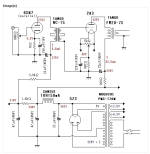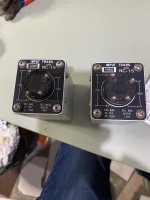Hello to everybody, I came across with couple of Tango NC-15 input trans, so I am thinking to use them for an 300A or 2A3 amplifier, I find a schematic but I don't know if is a good idea, please advise
Thank you
Acky
Thank you
Acky
Attachments
2a3 and 6SN7 are good sounding valves, so that's a good start. I don't know if you need to parallel the 2 halves with a 2a3.
The specs of the NC-15 of DC current, primary impedance, and inductance are the key factors that will determine if paralleling the 6SN7 triodes will work better or not.
If you parallel, I recommend using separate self bias resistors and bypass caps.
The article Parallel Tubes Effects in Glass Audio, Volume 12, Number 5 2000 addresses the reason for individual self bias, or use a 6SN7 that has extremely well matched triodes.
Example for a transformer that is rated at 12 mA.
Using a 6SN7 at 10 ma is fine. but paralleling the triodes and running each one at 5mA will raise the plate resistance, rp. look at the plate curves to see if that is true, a lower slope indicates higher plate resistance, rp. There is not always a gain by paralleling, it depends.
I try to be slightly conservative in the DC current, example output transformer: I use 60mA on a 65mA transformer.
I try to teach the concept.
Someone might want to use a 12AT7 and an NC-20, the answers are different, might work with parallel triodes. The high transconductance of the 12AT7 requires individual self bias RC for the cathodes.
If you parallel, I recommend using separate self bias resistors and bypass caps.
The article Parallel Tubes Effects in Glass Audio, Volume 12, Number 5 2000 addresses the reason for individual self bias, or use a 6SN7 that has extremely well matched triodes.
Example for a transformer that is rated at 12 mA.
Using a 6SN7 at 10 ma is fine. but paralleling the triodes and running each one at 5mA will raise the plate resistance, rp. look at the plate curves to see if that is true, a lower slope indicates higher plate resistance, rp. There is not always a gain by paralleling, it depends.
I try to be slightly conservative in the DC current, example output transformer: I use 60mA on a 65mA transformer.
I try to teach the concept.
Someone might want to use a 12AT7 and an NC-20, the answers are different, might work with parallel triodes. The high transconductance of the 12AT7 requires individual self bias RC for the cathodes.
Last edited:
one beautiful tube is E280F in triode mode with NC15 as loadI am thinking to use them for an 300A or 2A3 amplifier
It can develop a great swing with a good THD. The mu is also high.
The Rp is around 1k8 ohm
Walter

